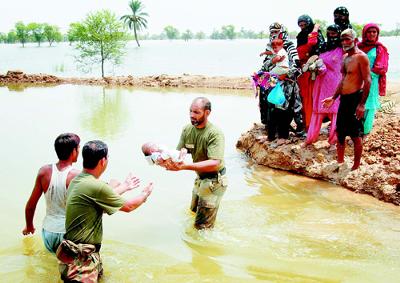by Shah Zaman Babar
(United Arab Emirates)

forces activities to save the lives
The dictates of the history proves that great nations have always confronted with greater challenges. In its proof of being a great nation, Pakistan has confronted greater challenges throughout in its entire history. By the grace of Almighty, it has always stood to test of time. In the recent past, this great country was hit by a natural calamity in the form of Earthquake-2005. This devastating earthquake took away over 73,000 lives in northern Pakistan. Besides, the natural calamity left deep effects in the form of thousands of injured and disabled people and destruction of houses, hospitals, academic institutes, and complete infrastructure in those areas.
The soil corrosion and lack of infrastructure caused internal displacement of millions of people. However, in a record time of two years, the nation was able to overcome the aftershocks of the earthquake by rehabilitating the affected families. A unique peculiarity while dealing with the disaster was that international community was forthcoming throughout through its financial, material and technical support. This support remained active during all phases, starting from the rescue operations through relief and then rehabilitation, continuing in some parts of the affected areas even now.
The nation has once again confronted with a devastating natural calamity in the form of the monsoon floods. Unlike previous history of floods in Pakistan, this time the flood has affected all areas from extreme north in the Gilgit-Baltistan and Naleem Valley to the adjoining areas of the Arabian Sea. Fortunately, there have been less loss of lives (approximately 1600 so far), but, almost half of the country has been badly affected. Counting on the provinces and federally administered areas, the floods have affected all of them simultaneously. Overall over seventy districts of Pakistan have been hit; either fully or partially. Correct estimates are yet to be made, as the effects of the flood are still going on. However, it is assumed that so far 20-25 million people have been directly affected by the floods.
The common pattern of damages due to flood include; collapse of houses and civic facilities, flow-down of infrastructure, roads, bridges, railway track, damages to bunds and water storages, designed for irrigation purposes. There has been a colossal loss to the standing crops and the irrigation system, designed to control the canals and water distribution system down to the field level. According to Bekele Geleta, Secretary General to International Federation of Red Cross and Red Crescent (IFRC), “Crops are gone. Infrastructure is gone, including canals; community canals and irrigation canals. To bring that back is going to take a long time. It could end up being five years.” As per initial estimates of the World Bank, the losses to crops would be over a $1billion. However, the real losses to the crops would be much more than that.
Indeed everything has been swept away in the flood-affected areas. Currently, major operations are underway in various parts for the rescue and relief of the affected people. In the temporary camps, there are requirements of shelters, essential foodstuff, and the life-saving medicines. Owing to the damages to the hospitals in the affected areas, already there is an out-break of the water borne diseases. The problems would grow once the floodwater starts receding and the displaced people would move back to their places for rehabilitation. Rehabilitation of over 20 million people would require colossal efforts, especially once it would be done in an environment, where the people have nothing in their hands, since they have lost their all belongings including their shelters and households.
The destruction is ongoing, more forecast till middle of September 2010.




